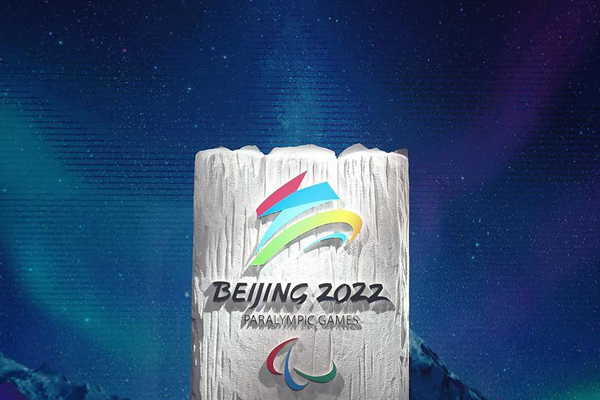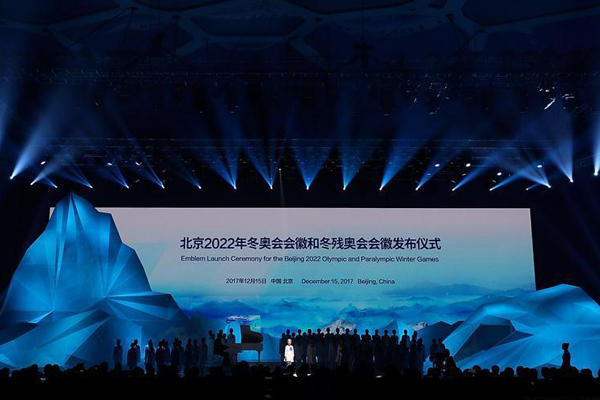
The emblem of Beijing 2022 Olympic Winter Games is unveiled during the emblem launch ceremony for the Beijing 2022 Olympic and Paralympic Winter Games in Beijing, capital of China, Dec 15, 2017. [Photo/Xinhua]

The emblem (L) of Beijing 2022 Olympic Winter Games and emblem of Beijing 2022 Paralympic Winter Games are seen during the emblem launch ceremony for the Beijing 2022 Olympic and Paralympic Winter Games in Beijing, capital of China, Dec 15, 2017.[Photo/Xinhua]
BEIJING — The emblems of the Beijing 2022 Olympic and Paralympic Winter Games, respectively named “Winter Dream” and “Flight”, were unveiled here on Dec 15.
The emblem launching ceremony was held at the National Aquatic Center, dubbed the “Water Cube” which staged the swimming events during the Beijing 2008 Games. In 2022, this venue will be transformed into an ice rink for curling games.
The unveiling came at 20:22 Beijing time, a number meant to mark the year 2022. Vice-Premier Zhang Gaoli, International Olympic Committee (IOC) Vice-President Yu Zaiqing and athlete representatives were present to officially launch the emblem of the Beijing 2022 Olympic Winter Games under the name “Winter Dream”.

The emblem of Beijing 2022 Olympic Winter Games is unveiled during the emblem launch ceremony for the Beijing 2022 Olympic and Paralympic Winter Games in Beijing, capital of China, Dec 15, 2017.[Photo/Xinhua]
Vice-Premier Liu Yandong, Secretary of the Communist Party of China Beijing Municipal Committee and President of the Beijing 2022 Organizing Committee Cai Qi, and Paralympic athlete representatives followed by launching the emblem of the Beijing 2022 Paralympic Winter Games.
“The emblems of Beijing 2022 combine Chinese culture, an international, modern style and winter sports together. They vividly manifest China’s national spirit, contemporary image and cultural charm, display the passion, youth and vitality of winter sports, convey the athlete’s spirit of going beyond themselves and expresses the glorious anticipation of 1.3 billion Chinese people toward Beijing 2022,” said Cai at the launch ceremony.

The emblem of Beijing 2022 Paralympic Winter Games is unveiled during the emblem launch ceremony for the Beijing 2022 Olympic and Paralympic Winter Games in Beijing, capital of China, Dec 15, 2017. [Photo/Xinhua]
International Olympic Committee (IOC) President Thomas Bach said via video that the Olympic emblem is a symbol of both “ambitions and dreams”.
“Today, Beijing is taking another important step on its way to make history — to make history as the first city in the world to host both the summer and winter editions of the Olympic Games,” he said.
Bach continued: “The unveiling of the official emblem for the Olympic Winter Games Beijing 2022 is a milestone on this exciting journey for China and the entire Olympic family. The emblem is a symbol of ambitions and dreams. It will build the excitement and anticipation in China and around the whole world for our shared goal of outstanding Olympic Winter Games Beijing 2022.”

Photo taken on Dec 15, 2017 shows the emblem launch ceremony for the Beijing 2022 Olympic and Paralympic Winter Games in Beijing, capital of China.[Photo/Xinhua]
“With the emblem, there will be a common image for people throughout the globe to connect with. It stands for the vision of Beijing 2022, showcasing the best of China to the world, a unique blend of modern and ancient traditions. And of course, bringing the joy of winter sports to a new generation in China and beyond,” he added.
International Paralympic Committee (IPC) President Andrew Parsons also expressed his well-wishes in a video. “It is an emblem that encapsulates the Paralympic spirit, but also Chinese culture.
“I am very excited about the Paralympic Winter Games in Beijing 2022. At Beijing 2008, we shaped the way that we organize and we deliver the Paralympic Summer Games and I am sure that Beijing 2022 will do the same for the Paralympic Winter Games.”
With its origin in the Chinese character “dong” (winter), the Olympic emblem integrates the spirit of Chinese calligraphy and eastern cultural heritage with a modern, global style. Through an artistic rendering, it represents a new image of and dream for China. It also expresses China’s vision and determination to host “a fantastic, extraordinary and excellent” Winter Olympics and Paralympics, and to encourage 300 million people in the country to participate in winter sports.
At the top of the emblem is a skater rushing forward, while at the bottom is a skier. The dynamic lines in the middle represent mountains, trails in the snow seen during winter sports and the silk ribbons which are often used when Chinese people celebrate the Lunar New Year, which will overlap with Beijing 2022.
The Paralympic emblem, featuring an athlete-centered concept, also combines Chinese calligraphy and Paralympic winter sports. Oriented around the Chinese character “fei” (flight), the emblem is an abstract image of an athlete who is fighting for victory, highlighting the spirit of and inspiration for the Paralympic Winter Games.
At the launch ceremony, a series of performances were staged with a theme of “Winter Olympic Dream,” further showcasing how a confident China can carry forward the Olympic spirit.
On July 31, 2016, the first anniversary of the announcement of Beijing’s successful bid to host the 2022 Olympic and Paralympic Winter Games, the organizers launched a worldwide campaign to seek emblem designs for the Games.
By Nov 30, 2016, at the end of four-month collection, Beijing 2022 received a total of 4,506 design proposals, about 2.2 times the number submitted for Beijing 2008. The eldest designer is 85 years old, and the youngest seven. Some designers even submitted their works in person to the emblem collection office. Over seven million people were involved in the emblem designs collection effect through the organizing committee’s official Weibo account or through other collection activities.
In October 2016, an emblem review committee grouping 15 Chinese and international judges was established. The members in the committee come from a wide range of fields, including design, art, sculpture, sports, media, and Paralympics.
“We received emblem designs from China’s 31 provinces, autonomous regions and municipalities, the Hong Kong and Macao Special Administrative Regions, and Chinese Taipei. Designers from 13 countries around world, including the US, the UK, France, Russia, Canada, Australia, Mexico, Japan, and South Korea, submitted their designs,” said Jiang Xiaoyu, President of the emblem review committee.
David Grossman, President of the International Council of Design and member of the review committee, said, “it was interesting to see that many different people made submissions. There were professionals, there were amateurs. I think there were probably some children, too, who submitted proposals. And it’s very interesting to see the interest from the public in creating such a rich basis for discussion.”
After rounds of selection and revision, the emblems “Winter Dream” and “Flight” eventually stood out and were adopted as the emblems of the 2022 Beijing Olympic and Paralympic Winter Games.
Fan Di’an, member of the emblem review committee noted the interesting similarities in many of the designs submitted.
“When we reviewed the proposals, we saw that the designers shared many similarities in choosing the elements for the emblems: that is, to combine ice and snow sports with Chinese culture. This was very impressive,” Fan said.
Visually, Jiang and other committee members believe that the emblem “Winter Dream” stood out as an ingenious design with vivid composition. It not only integrates ice-and-snow sports with calligraphy, but also creates a sense of the times based on the rhythms of abstract formation, which can be easily spread internationally.
Grossman called the selection process “very serious.”
“I’ve participated in a lot of such judging, and I have to say that rarely have I had an experience that was so serious. Everybody in the process took it as something very important and was very serious and careful in their discussions. There were long discussions and different opinions, but it was a very positive process and very impressive,” Grossman recalled.
The chief designer of the two emblems is Lin Cunzhen, deputy dean of China Central Academy of Fine Arts’ Design School. She started her work in the field of Olympic emblem design back in 2003.
“The design of the two emblems was guided by the athlete-centered concept of the Games. The Olympic emblem was initially drawn onto the idea of the Chinese character ‘dong’ (winter) in the bid emblem, with the character rendered in Chinese calligraphy, representing Chinese culture. Meanwhile, a pattern combining ice-sports and snow-sports was used to represent Olympic Games,” said Lin.
Lin is also the designer of the emblem for the 2014 Nanjing Youth Olympics and she has participated in a series of designs during Beijing 2008. But she says this time, her experience really stood out.
“I have worked on these emblems for a year with the revision group, which never took place during my other designs,” said Lin. She recalls times that she even worked to the verge of collapse, but says she was able to overcome it.
The general public will soon be able to get their hands on merchandise carrying the new logos. The organizers of Beijing 2022 will soon start test operations for the sale of franchised products, and China Post will publish a commemorative stamp on December 31. Franchised products of Beijing 2022 will be on offer from an online store starting on Dec 16.
